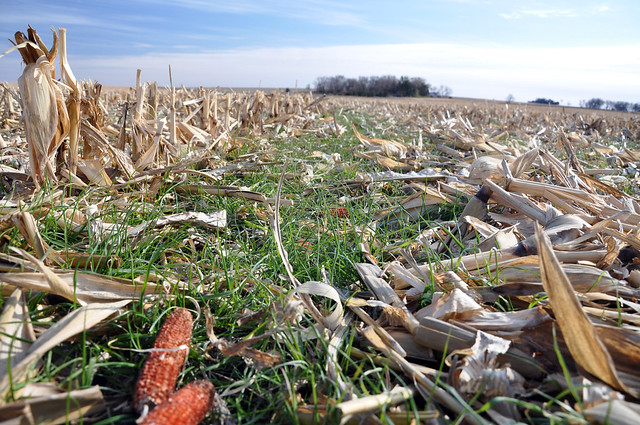“The food crisis can only be conquered with even greater intensification.” “A new ‘Green Revolution’ to match that of South-East Asia is needed to improve yields further.” “Organic farming is a cute idea, but it will never replicate the yields of conventional agri-business.” Who hasn’t heard those arguments? And felt defeated by the challenge to tackle food security (aka enough food for all – of course there are also distribution issues) and sustainability in the future?

Image by NRCS Soil Health, via Flickr Creative Commons.
Well, according to an intensive, 9-year long research effort conducted by the US Department for Agriculture, Iowa State University and the University of Minnesota, these two aims are not contradictory at all.
The so-called Marsden Farm study is one of the longest-lasting large-scale comparison studies of the recent years that attempted to contrast different farming approaches for the same crop.
From 2003 to 2011, they grew three different farming systems next to one another, in the same soil and under the exact same conditions (and using GE [genetically engineered] and non-GE crops in each system):
(1) a replication of a typical Mid-Western farming system, alternating corn and soy bean in a two-year cycle, and using chemical fertilizers and herbicides;
(2) a three-year rotation adding small grains and a red clover cover crop; and
(3) a four-year rotation adding in alfalfa as well, which is a great livestock feed.
What did they discover?
- More rotation = more yields! The systems with more crop rotation (2 and 3) had on average 4 percent higher corn yields and 9 percent higher soy bean yields.
- More rotation = less fertilizer and input requirements! The conventional system had significantly higher fertilizer use, and the gap only increased over time (presumably as soil quality improved). Synthetic nitrogen use, for example, decreased by 80 – 86 percent in the crop rotation systems.
- More rotation = less herbicide requirements! The rotation systems used 88 percent less herbicides through natural weed control. Relatedly, herbicide-caused freshwater toxicity was 200 times lower after 9 years.
- More rotation = less energy! The researchers found that the more diversified systems used around half the energy of the conventional system.
- More rotation = more resilience! When a case of a soybean disease (the Sudden Death Syndrome) broke out in 2010, in the conventional system 97% of non-GE plants and 27% of GE plants were affected. On the other hand, less than 9 percent of the crops in the diverse rotations were affected.
- More rotation = more choice! While GE plants outperfomed non-GE varieties in the conventional system, the researchers wrote that “with diverse rotations, farmers can choose between GE and non-GE without jeopardizing net returns. Diverse rotations outperformed conventional in yield regardless of the crop variety.“
- Furthermore, the production of small grains and alfalfa as livestock feed enables an integrated crop and livestock production system, in which the cow manure can be used as fertilizer instead of becoming a waste product.
- Finally, profits remained comparable throughout the systems, and yields were high even during the transition period, which is an common concern of farmers considering an economically viable switch to more sustainable practices. It was also noted that the rotation-based systems were less reliant on input price changes, including the price of fossil fuel, which might make them even more profitable than conventional systems in the case of a rise in oil prices.
The researchers stressed that an overall increase in system resilience was notable, which is especially interesting in the context of climate change and more extreme weather conditions, as well as the potential emergence of herbicide-resistance weeds.
Have you heard of this study? What are your thoughts?
Bonus: Have a look at the Leopold Center for Sustainable Agriculture’s article about the findings, and their brochure with more concrete information. In addition, this is a great resource by the USDA on soil health and conservation.
Reblogged this on Science on the Land and commented:
argylesock says… I hadn’t heard of this science but now that I have, the results sound too good to be true. Every one of the conclusions got me thinking, ‘This is what we allotmenteers have been saying for years!’ On the principle that if something sounds too good to be true, it probably isn’t true, I checked who funded this research and I haven’t yet seen anything dodgy there. In other words, I’m inclined to believe in all of this study’s conclusions. I wonder how well it could be reproduced by other researchers. Also, how applicable are these methods in different agricultural regions and for different crops?